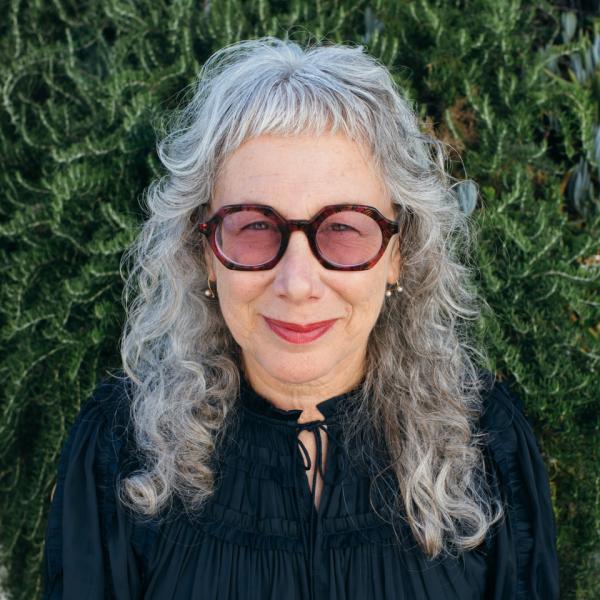
Recognition
2022 AIGA Medal
Born
1955, Sharon, Massachusetts
By Margaret Andersen
August 22, 2022
Recognized for her presence and voice in the community as an educator and author—brilliant yet accessible, her work elevates under-recognized designers through stunning publications, insightful storytelling, and an eye toward design in everyday life.
Designers aren’t created in a vacuum. They’re shaped by their environments and the people around them, and it’s through mentorship and collaboration that they grow within their creative communities. For Louise Sandhaus, her role as a design educator and mentor reaches back nearly twenty-five years. She’s inspired countless young designers through her courses at CalArts, while also serving as co-director of the school’s Graphic Design Program, an AIGA board member, and Chair of the AIGA Design Educators Community steering committee. Her research and authorship challenges the traditional design canon by uplifting the stories and work of unsung makers, and her design practice pushes forward new ways of thinking in exhibition design and the curatorial process.
Looking back on her career, Sandhaus credits her own mentors and colleagues as catalysts for her creative development, which in turn has led her to continue their legacy of fostering the next design generation. “The training of my mentors changed the trajectory of my work, strengthening my conceptual thinking to allow me to bring writing as well as visual design into my practice,” she said.
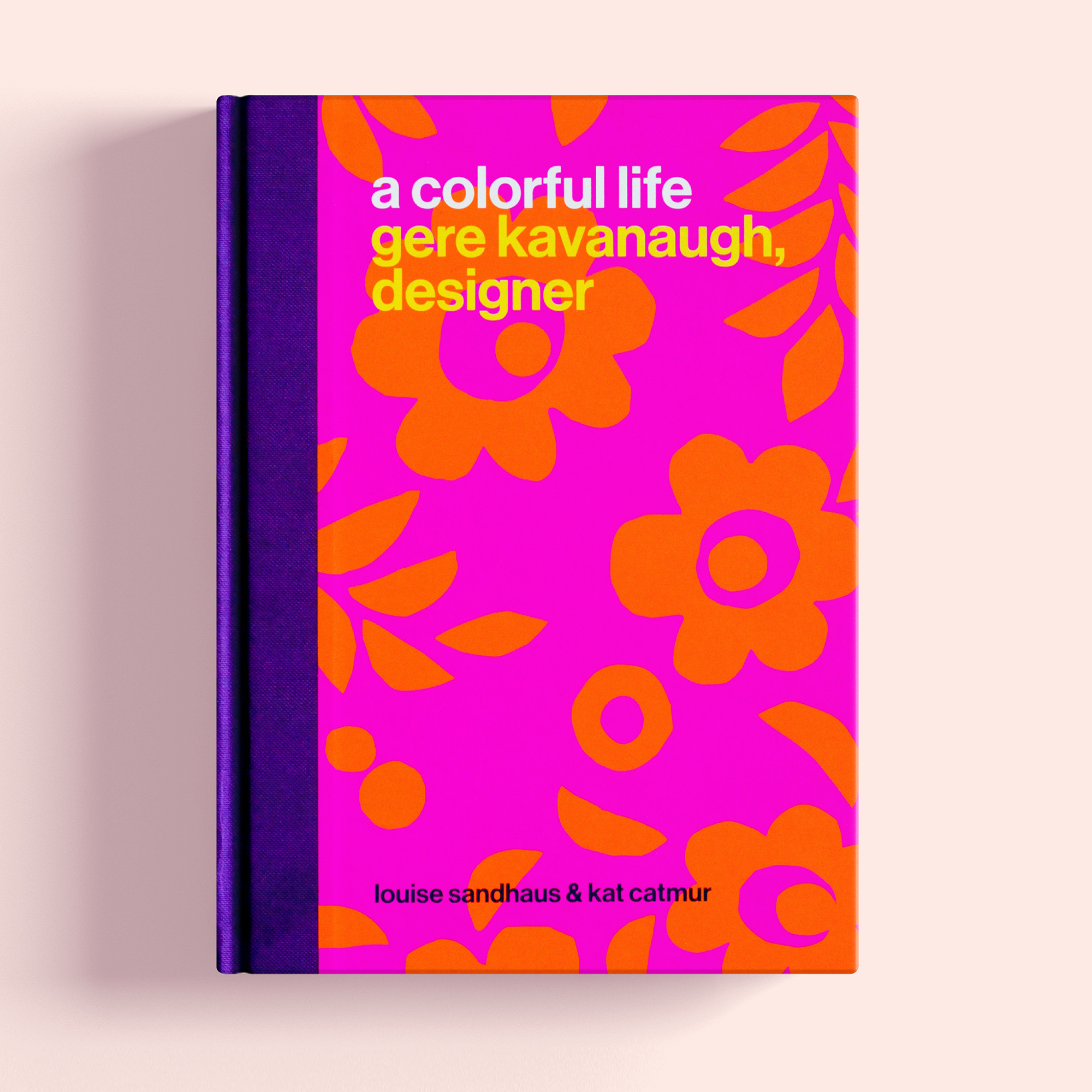
A Colorful Life: Gere Kavanaugh, Designer (cover). 2019. Author: Louise Sandhaus and Kat Catmur. Design: Louise Sandhaus and Kat Catmur. Typefaces: Pitch, Klim Type Foundry, designed by Kris Sowersby and Neue Haas Grotesk, Linotype, designed by Max Miedinger and Christian Schwartz. Editor: Sara Stemen. Publisher: Princeton Architectural Press. Photo credit: Marc Alt. Image courtesy of Louise Sandhaus.
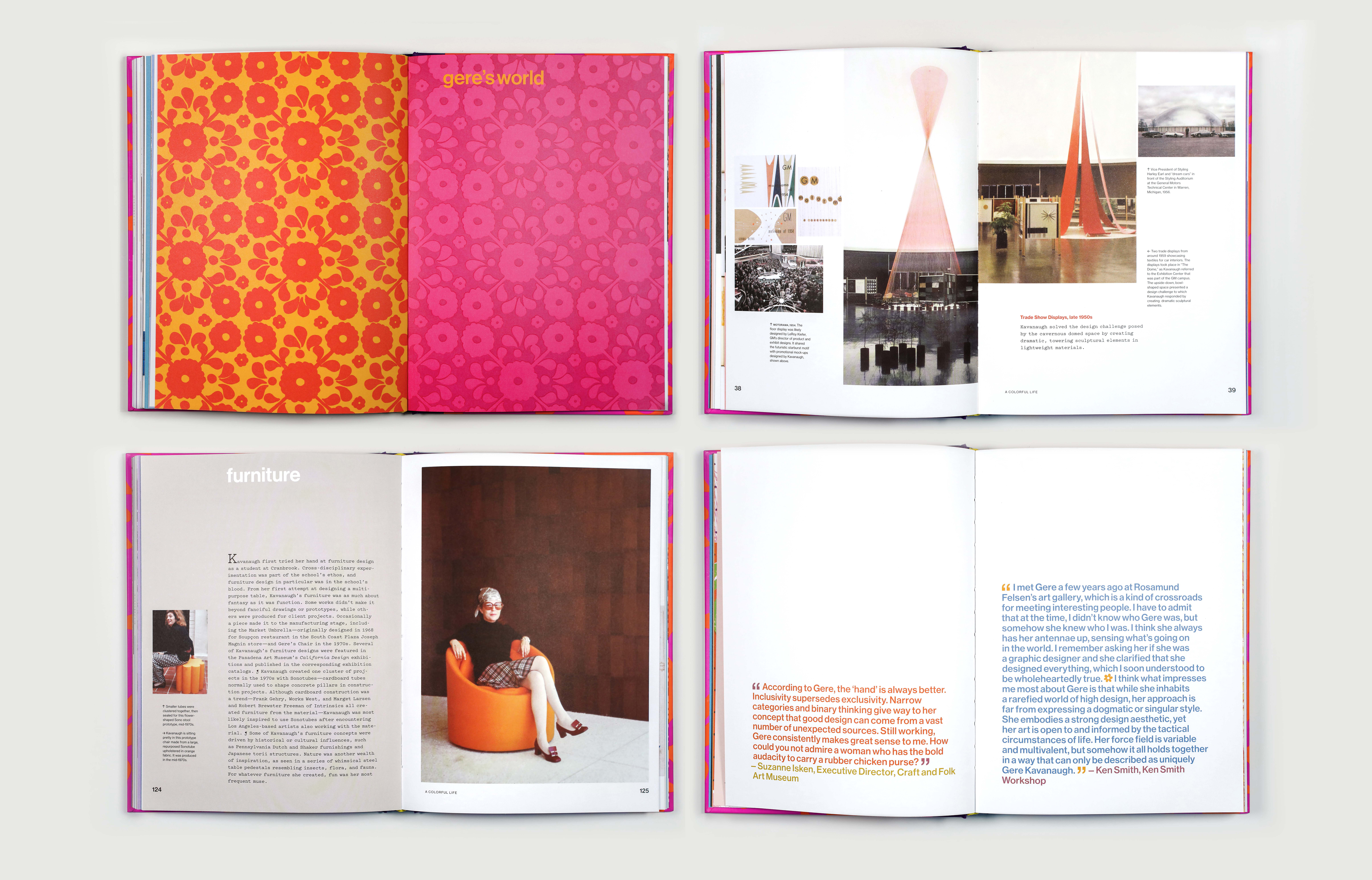
A Colorful Life: Gere Kavanaugh, Designer (various spreads). 2019. Author: Louise Sandhaus and Kat Catmur. Design: Louise Sandhaus and Kat Catmur. Typefaces: Pitch, Klim Type Foundry, designed by Kris Sowersby and Neue Haas Grotesk, Linotype, designed by Max Miedinger and Christian Schwartz. Editor: Sara Stemen. Publisher: Princeton Architectural Press. Photo credit: Marc Alt. Image courtesy of Louise Sandhaus.
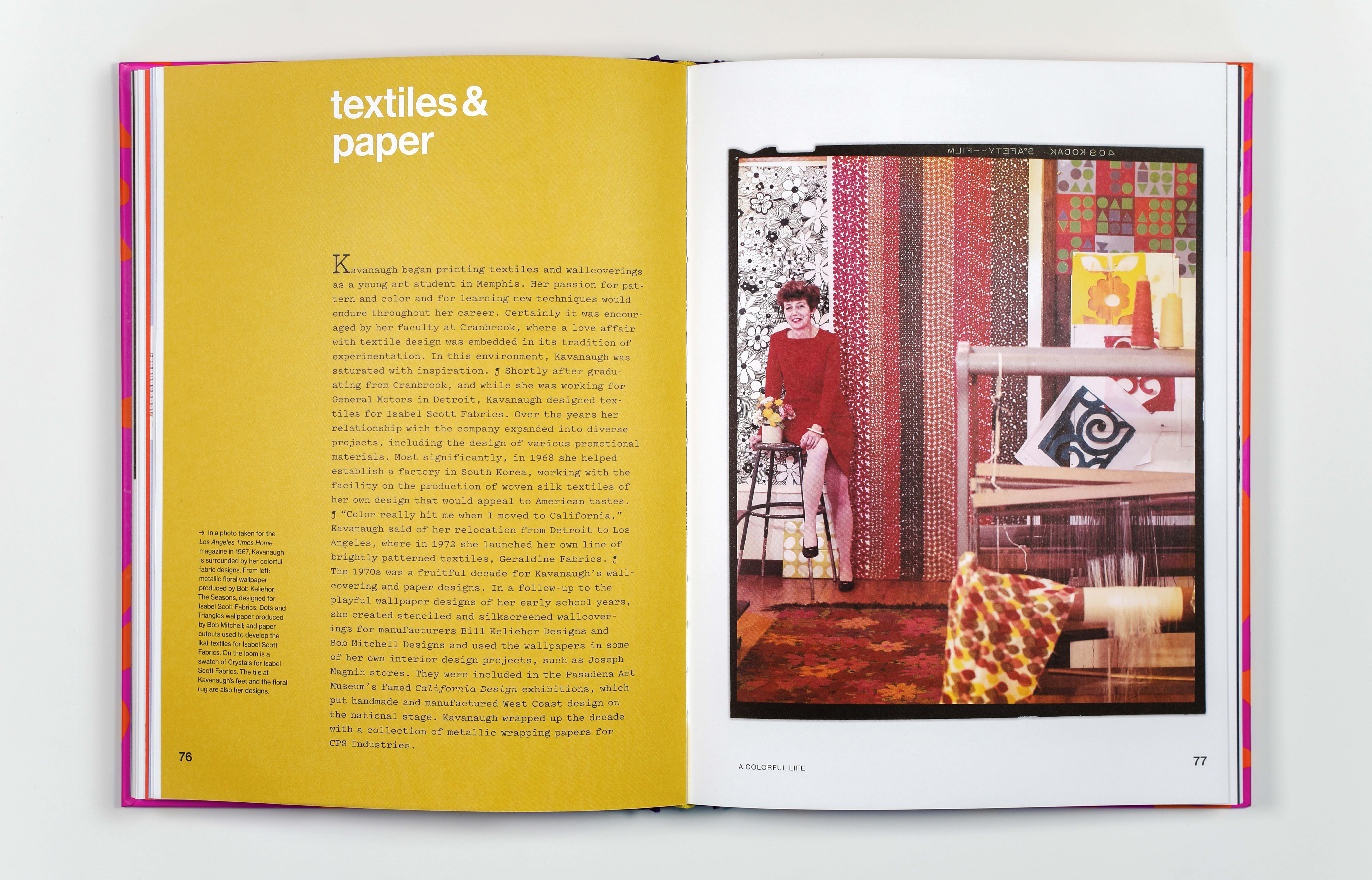
A Colorful Life: Gere Kavanaugh, Designer (featured spread). 2019. Author: Louise Sandhaus and Kat Catmur. Design: Louise Sandhaus and Kat Catmur. Typefaces: Pitch, Klim Type Foundry, designed by Kris Sowersby and Neue Haas Grotesk, Linotype, designed by Max Miedinger and Christian Schwartz. Editor: Sara Stemen. Publisher: Princeton Architectural Press. Photo credit: Marc Alt. Image courtesy of Louise Sandhaus.
Press Release
Louise Sandhaus will be honored with the AIGA Medal at the AIGA Design Conference during the afternoon General Session on Friday, October 21, 2022. The Awards Reception be held Friday, October 21, 2022 at 6:45 p.m. Pacific. Reception tickets support AIGA scholarships. Come celebrate with us!
Even before she studied design formally, Sandhaus had always been surrounded by it. Born in 1955 near Boston, MA to parents who were both creative professionals, Sandhaus grew up in the kind of design-filled home that had a printmaking workshop—which doubled as a ping pong table—in its basement. Her mother Harriet Sandhaus worked for a local paper, penning an illustrated column called "Notes of a Shopper by Julie," and her father Norman Sandhaus was an art director, who produced things like aeronautics company manuals and tourist brochures. Creativity thrived in the Sandhaus home; however, when her family relocated to Orlando, FL, the move left her feeling alienated by her new conservative surroundings. She’s always possessed a rebellious spirit—that innate desire to push back against convention and conformity—and it was that quality that helped her forge her own path into the world of design even in a city that was a world away from the traditional design education hubs.
After interning at an ad agency during high school, Sandhaus went on to enroll in a two-year program in advertising design at The Art Institute of Fort Lauderdale, FL. She was surprised to discover that many of her teachers had been working designers in New York and brought with them the aesthetics and knowledge of east coast modernism and the New York art scene.
The design and conceptual thinking skills she acquired in the short program helped her land a job back in Boston at East West Journal, an alternative lifestyle magazine. She moved up quickly in the company, beginning as a staff designer before transitioning to art director by 23. After gaining recognition for her work, she decided to leave the magazine to freelance and experiment with her craft, all while teaching at the Art Institute of Boston.
By the mid-1980s Sandhaus was living in Cambridge, MA, where she met Muriel Cooper, the first design director of MIT Press. Cooper was starting to develop ideas around digital design, and it was through their conversations and informal mentorship that Sandhaus was inspired to pursue a graduate degree. While exploring grad school options, she took a spontaneous trip to Santa Monica, CA to visit an old friend. That decision was a pivotal moment for Sandhaus, one that would begin a lifelong love affair with the west coast and California design. “Living on the east coast my whole life, I barely even knew California existed,” Sandhaus said. “But when I stepped off that plane, I thought I’d died and gone to paradise. That’s what it felt like to be here.”
During her trip, she connected with several local designers, including Lorraine Wild, a professor at CalArts in Valencia, 30 miles north of downtown Los Angeles. The campus, just a stone’s throw from Six Flags Magic Mountain, is situated between swaths of tract housing, fast food drive-thrus, and the freeway. It’s an unexpected location for a school with such a vibrant history of avant garde thinking and making, and yet it’s also quintessentially LA, a melting pot of creativity and culture whose gifts to its citizens are often tucked away in unassuming strip malls or suburban neighborhoods far from the arts district or downtown core.
“When I visited CalArts, I instantly knew this is where I belong,” said Sandhaus. In many ways she saw herself reflected in the school; that same rebellious spirit was palpable. “CalArts pushes you in ways you don’t anticipate; it’s the curriculum and experimental environment that enables students to evolve into designers that they’d never expect they’d become,” she said. At CalArts, she received her BFA and MFA back-to-back in 1993 and 1994, followed by a stint at the Jan van Eyck Academy in The Netherlands. She returned to the US, and CalArts, in 1996, when she was hired as a faculty member. It’s here that she continues to teach to this day.

Earthquakes, Mudslides, Fires & Riots: California and Graphic Design, 1936–1986 (cover). 2014. Author: Louise Sandhaus with essays by Denise Gonzales Crisp, Lorraine Wild, and Michael Worthington. Design: LSD (Louise Sandhaus Design) with Jens Gehlhaar, Thomas Kracauer, Kaoru Matsushita, Christopher Morabito, Derrick Schultz, Hayden Smith. Diagram Design: Kat Catmur with Benjamin Woodlock. Typeface: CIA Compendium designed by Jens Gehlhaar. Project Director: Diana Murphy. Editor: Anne Thompson. Publisher: Metropolis Books (International edition: Thames & Hudson). Image courtesy of Louise Sandhaus.
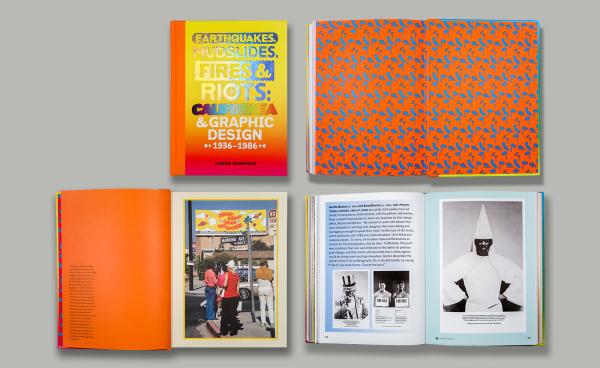
Earthquakes, Mudslides, Fires & Riots: California and Graphic Design, 1936–1986 (image spread featuring the work of Archie Boston, Jr.). 2014. Author: Louise Sandhaus with essays by Denise Gonzales Crisp, Lorraine Wild, and Michael Worthington. Design: LSD (Louise Sandhaus Design) with Jens Gehlhaar, Thomas Kracauer, Kaoru Matsushita, Christopher Morabito, Derrick Schultz, Hayden Smith. Diagram Design: Kat Catmur with Benjamin Woodlock. Typeface: CIA Compendium designed by Jens Gehlhaar. Project Director: Diana Murphy. Editor: Anne Thompson. Publisher: Metropolis Books (International edition: Thames & Hudson). Photo credit: Marc Alt. Image courtesy of Louise Sandhaus.

Earthquakes, Mudslides, Fires & Riots: California and Graphic Design, 1936–1986. The Indies & the Industry Influences & Intersections diagram. 2014. Author: Louise Sandhaus with essays by Denise Gonzales Crisp, Lorraine Wild, and Michael Worthington. Design: LSD (Louise Sandhaus Design) with Jens Gehlhaar, Thomas Kracauer, Kaoru Matsushita, Christopher Morabito, Derrick Schultz, Hayden Smith. Diagram Design: Kat Catmur with Benjamin Woodlock. Typeface: CIA Compendium designed by Jens Gehlhaar. Project Director: Diana Murphy. Editor: Anne Thompson. Publisher: Metropolis Books (International edition: Thames & Hudson). Photo credit: Marc Alt. Image courtesy of Louise Sandhaus.
By 1998, Sandhaus was co-director of the graphic design program at CalArts. In the same year, she established LSD (Louise Sandhaus Design), her own design studio. It has gone on to produce work ranging from publications and software design to large-scale museum exhibitions, such as Made in California: Art, Image, and Identity, 1900–2000 for the Los Angeles County Museum of Art (LACMA). Partnering with architects Tim Durfee and Iris Anna Regn to create the massive exhibition, Sandhaus’s groundbreaking approach reimagined museum exhibition design by applying user experience design principles to the exhibition design process.
This also laid the foundations for her first book, Earthquakes, Mudslides, Fires & Riots: California and Graphic Design 1936–1986. While developing the LACMA exhibit, Sandhaus became aware of California's break with European and east coast definitions of art. This notion of California defining art on its own terms would help to inform inform her ideas going forward with future projects. After LACMA wrapped, she researched and interviewed designers for more than ten years, culminating in her 420-page landmark study of the west coast’s rich design past. Wild was a close collaborator on the endeavor, helping Sandhaus define the four sections of the book. The design of the publication itself is a synthesis of the west coast aesthetic: From its day-glo gradient cover and palm tree patterned endpapers to the countless photographs and interviews printed on luxe, color saturated paper stocks, it’s a celebration of Californian design in all its multifaceted forms.
Sandhaus’s second book expanded further on one of the female designers included in her first, Gere Kavanaugh. Co-written by Sandhaus and Kat Catmur, her former student at CalArts, A Colorful Life: Gere Kavanaugh, Designer chronicles the prolific career of Kavanaugh, whose work included home decor, car interiors, furniture, sculptures, graphics, toys, and textiles. Published by Princeton Architectural Press, the book was a winner of the AIGA 50 Books | 50 Covers of 2019 competition, and it is a testament to Sandhaus’s commitment to expanding graphic design literature.

The People’s Graphic Design Archive. Landing page, People’s Graphic Design Archive site prototype, 2022. Founder: Louise Sandhaus. Co-Directors: Brockett Horne, Briar Levit, Louise Sandhaus, Morgan Searcy. Designer: Abby Chen. Developer: Rob Meek. Design Advisors: Stephen Coles, Kate Long, Nick Sherman. Typefaces: Quadrant Text Regular and Regular Italic, designed by Vincent Chan, Matter of Sorts and Neue Haas Grotesk, Linotype, designed by Max Miedinger and Christian Schwartz. Image courtesy of Louise Sandhaus.
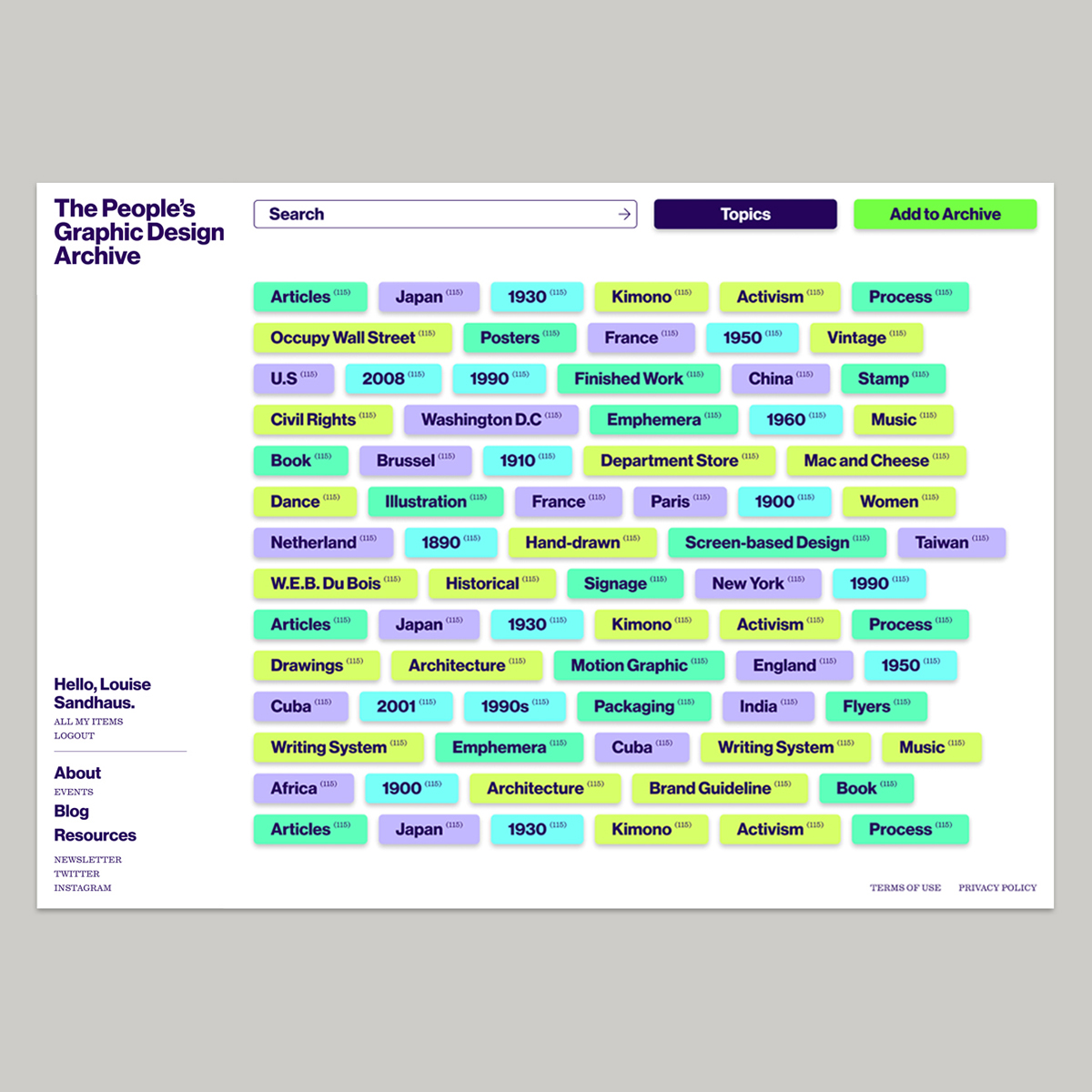
The People’s Graphic Design Archive. Topics page, People’s Graphic Design Archive site prototype, 2022. Founder: Louise Sandhaus. Co-Directors: Brockett Horne, Briar Levit, Louise Sandhaus, Morgan Searcy. Designer: Abby Chen. Developer: Rob Meek. Design Advisors: Stephen Coles, Kate Long, Nick Sherman. Typefaces: Quadrant Text Regular and Regular Italic, designed by Vincent Chan, Matter of Sorts and Neue Haas Grotesk, Linotype, designed by Max Miedinger and Christian Schwartz. Image courtesy of Louise Sandhaus.
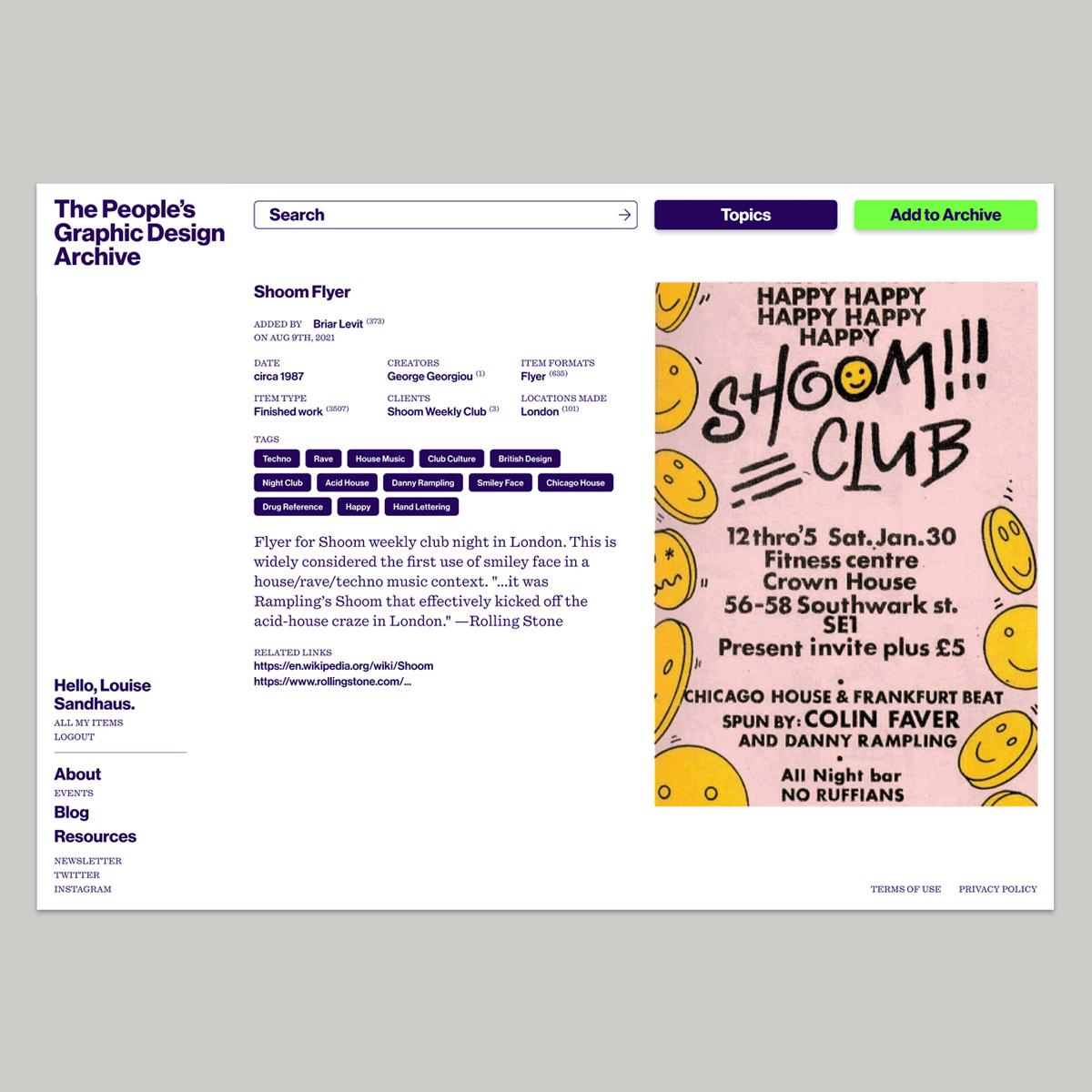
The People’s Graphic Design Archive. Item page, People’s Graphic Design Archive site prototype, 2022. Founder: Louise Sandhaus. Co-Directors: Brockett Horne, Briar Levit, Louise Sandhaus, Morgan Searcy. Designer: Abby Chen. Developer: Rob Meek. Design Advisors: Stephen Coles, Kate Long, Nick Sherman. Typefaces: Quadrant Text Regular and Regular Italic, designed by Vincent Chan, Matter of Sorts and Neue Haas Grotesk, Linotype, designed by Max Miedinger and Christian Schwartz. Image courtesy of Louise Sandhaus.
In many ways, Sandhaus’s contributions to design discourse are, in a sense, an extension of her role as a mentor to the design community. Reaching people through her writing, in the pages of magazines like Eye, ID, and Metropolis, and books like The Women of Design and Information Design Handbook, allows her to continue to educate others outside of the classroom setting.
Sandhaus’s latest contribution to the field is The People’s Graphic Design Archive, a crowd-sourced virtual archive that aims to expand, diversify, and preserve graphic design history. The educator realized the urgent need for a digital archive of lesser known design work after interviewing many local designers who had boxes of unarchived work stored out of sight. Maintaining a physical archive of design work demands space, time, and financial resources that not everyone has access to, and without an accessible way to document it, that history will disappear.
“By utilizing a digital platform, we can work collectively as a design community to discover, document, and preserve our shared design history,” Sandhaus said. The People’s Graphic Design Archive enables any user to upload original work, photos, letters, oral histories, anecdotes, published and unpublished essays, videos, and audio, as well as links to other relevant archives and websites. In uplifting the marginalized stories from design that many of us don’t even know existed, the archive fundamentally de-centers the exclusive legacy of modernism. “At its core, it’s about honoring and recognizing that everything is valued, and every person is valued, and that anyone can contribute to preserving this history,” said Sandhaus.
Though the project will continue to evolve, the ethos of the People’s Graphic Design Archive has been evident in Sandhaus’s work throughout her career: Her dedication to expanding design discourse in the field and in the classroom is helping to create a more equitable industry. When asked what continues to drive her creative process, Sandhaus said, “There's a kind of vitality gained in sharing and receiving knowledge, a reciprocity that comes when we listen to one another, as teachers, as students, as colleagues. That exchange is what keeps my work moving forward.”
Further Reading
CalArts. “Louise Sandhaus.” Accessed July 27, 2022. https://art.calarts.edu/faculty-and-staff/louise-sandhaus.
Jones, Cassandra C. “Golden State of Mind.” Vortex. Accessed July 27, 2022. https://www.theojaivortex.com/home/louise-sandhaus.
Morley, Madeleine. “The First Thing I Ever Designed: Louise Sandhaus’ Shelved UX for Taco Bell.” AIGA Eye on Design, March 14th, 2016, https://eyeondesign.aiga.org/the-first-thing-i-ever-designed-louise-sandhaus-ux-for-taco-bell.
Morley, Madeleine. “The Cost of Free Love and the Designers Who Bore It—Meet the Women of Psychedelic Design.” AIGA Eye on Design, March 7th, 2019, https://eyeondesign.aiga.org/women-of-psychedelic-design.
Mungia, Ryan. “The People’s Graphic Design Archive Is Rethinking How We Talk About Design History.” AIGA Eye on Design, April 19th, 2021, https://eyeondesign.aiga.org/the-peoples-graphic-design-archive-is-rethinking-how-we-talk-about-design-history.
The People’s Design Archive. “About.” Accessed July 27, 2022. https://www.peoplesgdarchive.org/about.
Sandhaus, Louise. “Many Images, Many Possibilities: Expanding our History.” Filmed June 2018 at TEDxUCLA, Los Angeles, CA. Video, 13:01. https://www.ted.com/talks/louise_sandhaus_many_images_many_possibilities_expanding_our_history.
Smith, Lilly. “Gere Kavanaugh’s “Radically Upbeat,” Distinctly West Coast Style Didn’t Just Come Out of California.” AIGA Eye on Design, May 2nd, 2019, https://eyeondesign.aiga.org/gere-kavanaughs-radically-upbeat-distinctly-west-coast-style-didnt-just-come-out-of-california.